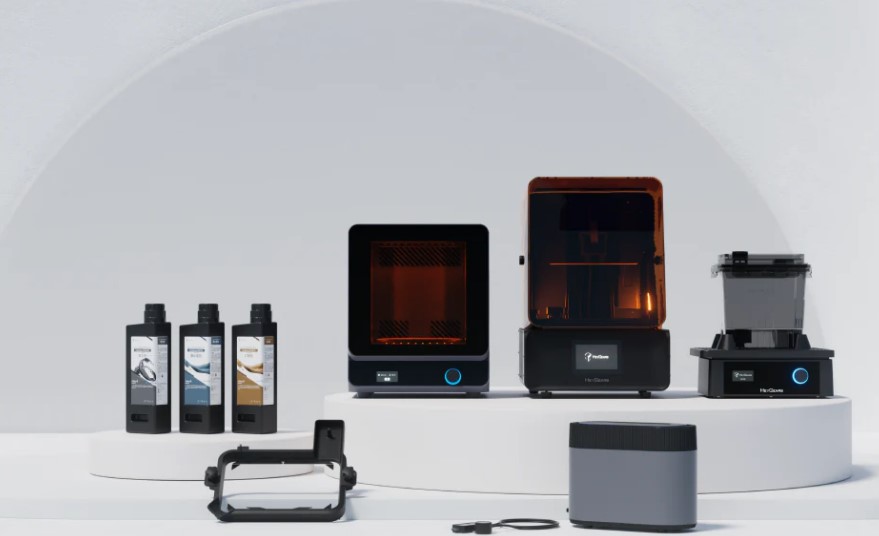When I got my first resin 3D printer, I thought picking the right material would be simple—just buy a bottle, pour it in, and hit “print.” But it didn’t take long before I realized that resin choice could make or break a project. Between flexible resins, high-temp resins, standard options, and specialty materials for dental or jewelry use, the world of resin printing is surprisingly vast.
If you’re new to resin 3D printing or trying to refine your print quality, this guide breaks down what to know before hitting that print button. Let’s talk about the most important factors to consider when choosing 3D printing resin—and how to make the best decision for your next project.
Why Resin Choice Matters More Than You Think
Unlike filament-based FDM printing, resin printing relies on photopolymerization—light hardening liquid resin into solid layers. This process gives SLA and MSLA printers their fine detail and smooth surface finishes. But here’s the catch: not all resins behave the same way.
Choosing the wrong resin can lead to:
-
Brittle prints that crack under stress
-
Dimensional inaccuracies
-
Slow curing or poor layer adhesion
-
Safety risks from toxic or improperly cured materials
The right resin, on the other hand, delivers sharp detail, consistent mechanical performance, and easier post-processing.
Key Factors to Consider When Choosing a 3D Printing Resin
1. Application: What Are You Printing?
Are you prototyping a mechanical part, casting jewelry, or printing tabletop miniatures? The purpose of your print should guide your resin choice.
-
Standard resin: Good for general-purpose models and aesthetic prints.
-
Tough resin: Best for mechanical parts that need durability and slight flexibility.
-
Flexible resin: Offers rubber-like properties for impact resistance or soft-touch parts.
-
Castable resin: Designed for burnout in casting processes—ideal for jewelry, dental, or art applications.
-
Biocompatible resin: Suitable for medical and dental applications, often regulated for skin or mucosal contact.
If you’re unsure, start with a high-quality standard resin. It’s versatile and user-friendly for most hobbyists.
2. Print Detail and Resolution
Some resins are formulated specifically for high-resolution prints—think 0.02 mm layer heights or ultra-fine surface finishes. These are perfect for highly detailed prints like miniature figurines or custom prototypes where aesthetics matter.
Look for descriptors like “high-detail,” “modeling,” or “precision” on the resin packaging or product listing. Not all printers can fully utilize these resins, so make sure your machine supports fine layer resolution.
3. Printer Compatibility
Not every resin works with every printer. Many desktop resin printers (like the Anycubic Photon or Elegoo Mars series) use 405nm UV light, which is the most common wavelength.
Still, always check:
-
Curing wavelength compatibility (typically 385nm or 405nm)
-
Recommended exposure times (your slicer settings will vary)
-
Viscosity (higher viscosity resins may require slower lifts or warmer ambient temps)
Manufacturers usually list compatible printers, or at least specs, to match.
4. Post-Processing Requirements
All resins require post-curing and washing, but some are easier to handle than others. Here’s what to consider:
-
Water-washable resins: Easier to clean, no need for isopropyl alcohol (IPA), but may be more brittle.
-
Solvent-based resins: Require IPA or acetone for cleanup, but often produce stronger, more durable prints.
-
Odor and toxicity: Low-odor or plant-based resins are great for home environments with limited ventilation.
Regardless of resin type, always wear gloves and work in a well-ventilated space. Even low-odor or “eco” resins can irritate skin or lungs if handled improperly.
5. Color and Finish
It might sound superficial, but color can affect print quality. Some pigments scatter UV light, resulting in less precise curing or altered exposure settings. Opaque or dark resins generally need longer exposure times than translucent or light-colored ones.
Some specialty resins also include matte finishes or transparency features—ideal for visual effects or aesthetic design projects.
6. Price vs. Performance
Like many things in life, you get what you pay for. Budget resins can be tempting, but they often suffer from:
-
Poor print consistency
-
Higher failure rates
-
Weaker mechanical properties
-
Increased smell or toxicity
That’s not to say you need to spend top dollar every time—but investing in a reputable resin brand will save you time and frustration in the long run.
Popular Resin Types and When to Use Them
Here’s a quick breakdown of common 3D printing resin categories:
| Resin Type | Best For | Notes |
|---|---|---|
| Standard Resin | Prototypes, figurines, decorative items | Affordable, good for beginners |
| Tough Resin | Functional parts, tools | Mimics ABS, better durability |
| Flexible Resin | Soft-touch parts, gaskets, grips | Elastic, but trickier to print |
| Castable Resin | Jewelry, dental, metal casting | Burns clean, needs special workflow |
| High-Temp Resin | Molds, heat-resistant components | Withstands high temperatures |
| Dental/Bio Resin | Medical models, aligners | Must meet regulatory standards |
Tips for Getting the Best Results from Your Resin
Even with the best resin, technique matters. Here are a few tips I’ve learned (often the hard way):
-
Always shake the resin bottle before use. Pigments and additives settle over time.
-
Use a resin thermometer or print in a warm room—cool resin slows curing.
-
Dial in your exposure times using a calibration print before starting a large project.
-
Filter used resin before pouring it back into the bottle to remove debris.
-
Store your resin in a cool, dark place—UV light and heat degrade it over time.
Final Thoughts
The world of 3D printing resin isn’t one-size-fits-all. As someone who started out just printing miniatures for fun, I quickly realized that having the right resin can mean the difference between a crisp, clean print or a warped, failed mess. Whether you’re crafting mechanical parts, fine art, or something in between, investing a little time into understanding resin properties pays off in print quality and reliability.
Take the time to research, test, and tweak—your prints (and your patience) will thank you.
Read more: https://theguestblogs.com/






